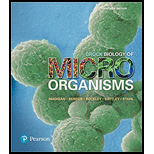
BROCK BIOL. OF MICROORGAN.-W/ACCESS >I
15th Edition
ISBN: 9780134810058
Author: MADIGAN
Publisher: PEARSON
expand_more
expand_more
format_list_bulleted
Question
Chapter 28.1, Problem 1CR
Summary Introduction
Laboratory-associated infections (LAIs) are also known as laboratory-acquired infections or occupational illness. LAIs may arise in clinical laboratories, animal facilities, and also in production installations. LAIs are of community health concern, as an infected worker may transmit the infection to his relatives, colleagues, and family members. In the United States (U.S) about 500,000 laboratory workers are at risk of exposure to contagious agents, which may cause diseases that vary from mild to life-threatening infections.
Expert Solution & Answer
Want to see the full answer?
Check out a sample textbook solution
Students have asked these similar questions
5. Explain and how infection control measures differ in the home versus the hospital ?
Q Explain how the infectivity of a pathogen iscorrelated with the epidemic spread of a disease invarious populations.
Provide examples of persistent and transforming infections, describing their effects on the host
Chapter 28 Solutions
BROCK BIOL. OF MICROORGAN.-W/ACCESS >I
Ch. 28.1 - The use of personal protective equipment (PPE) is...Ch. 28.1 - Identify and discuss the standard safety...Ch. 28.1 - Prob. 1CRCh. 28.2 - Prob. 1MQCh. 28.2 - How can the spread of HAIs be controlled?Ch. 28.2 - Prob. 1CRCh. 28.3 - What are the key points necessary for proper...Ch. 28.3 - Identify culture methods and conditions used for...Ch. 28.3 - QWhy is it important to process clinical specimens...Ch. 28.4 - Describe the disc diffusion test and the Etest for...
Ch. 28.4 - What is the value of antimicrobial drug...Ch. 28.4 - QDescribe the disc diffusion test for antibiotic...Ch. 28.5 - Explain the reasons for changes in antibody titer...Ch. 28.5 - Describe the method, time frame, and rationale for...Ch. 28.5 - What advantages do monoclonal antibodies have...Ch. 28.5 - QWhy does antibody titer rise after infection? Is...Ch. 28.6 - How is the bivalence of antibodies significant for...Ch. 28.6 - What are the advantages and disadvantages of...Ch. 28.6 - Why are agglutination tests so widely used in...Ch. 28.7 - Prob. 1MQCh. 28.7 - Compare the advantages and disadvantages of EIA,...Ch. 28.7 - Prob. 1CRCh. 28.8 - What advantage(s) does nucleic acid amplification...Ch. 28.8 - How do quantitative PCR (qPCR) and qualitative PCR...Ch. 28.8 - Distinguish between quantitative and qualitative...Ch. 28.9 - Compare and contrast live attenuated vaccines,...Ch. 28.9 - Identify the advantages of alternative...Ch. 28.9 - QList the immunizations recommended for children...Ch. 28.10 - Prob. 1MQCh. 28.10 - How does the activity of each antibiotic class...Ch. 28.10 - What are the sources of aminoglycosides,...Ch. 28.10 - Antibiotics are chemically diverse antimicrobial...Ch. 28.11 - What steps in the viral maturation process are...Ch. 28.11 - Why are there fewer clinically effective...Ch. 28.11 - Why is host toxicity a common problem with...Ch. 28.12 - Identify the basic mechanisms of antibiotic...Ch. 28.12 - What does vancomycin have in common with...Ch. 28.12 - Prob. 3MQCh. 28.12 - What practices contribute to the spread of...Ch. 28 - Define the procedures you would use to isolate and...Ch. 28 - Prob. 2AQCh. 28 - Describe three important reasons why semisynthetic...Ch. 28 - Imagine yourself as a clinical microbiologist with...
Knowledge Booster
Learn more about
Need a deep-dive on the concept behind this application? Look no further. Learn more about this topic, biology and related others by exploring similar questions and additional content below.Similar questions
- Q How is Neisseria meningitides typically transmittedand what are the symptoms of full-blown meningitiscaused by this bacterium?arrow_forwardExplain the concept of portal of entry, and list the major portals ofentry with examples of associated infections.arrow_forward1. What is the best antibiotic for treating a UTI?arrow_forward
- a. Suggest several reasons why respiratory, surgical, and gastrointestinalinfections are the most common health-care-associated infections.b. Name several measures that health care providers must exercise atall times to prevent or reduce these types of infections.arrow_forwardQ.No.2. Explain the observations that different pathogens infect different parts of the hostarrow_forwardI. What is the difference of TB, PTB, MDR-TB and XDR-TB?arrow_forward
- Explain 10 ways the human body prevents infectionsarrow_forwardExplain what is happening during each stage of infection. Compare and contrast: systemic, local, and focal infections; primary versus secondary infections; infection versus intoxication.arrow_forwardDiscuss important aspects of health-care-associated infections andtheir impact on patients in clinical settings.arrow_forward
arrow_back_ios
SEE MORE QUESTIONS
arrow_forward_ios
Recommended textbooks for you
 Biology (MindTap Course List)BiologyISBN:9781337392938Author:Eldra Solomon, Charles Martin, Diana W. Martin, Linda R. BergPublisher:Cengage Learning
Biology (MindTap Course List)BiologyISBN:9781337392938Author:Eldra Solomon, Charles Martin, Diana W. Martin, Linda R. BergPublisher:Cengage Learning

Biology (MindTap Course List)
Biology
ISBN:9781337392938
Author:Eldra Solomon, Charles Martin, Diana W. Martin, Linda R. Berg
Publisher:Cengage Learning

Infectious Diseases - How do we control them?; Author: Let's Learn Public Health;https://www.youtube.com/watch?v=2JWku3Kjpq0;License: Standard Youtube License